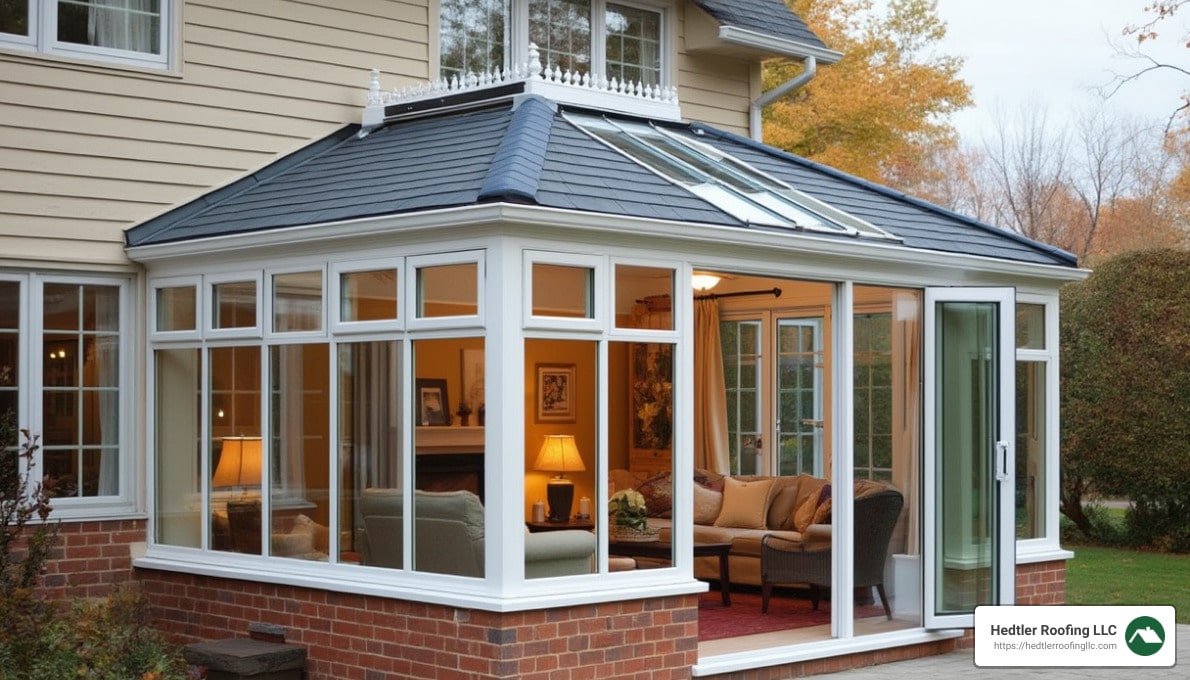Lightweight Conservatory Roof Replacement: Top 5 Benefits
Changing your conservatory with a lightweight conservatory roof replacement is a simple way to make the space more enjoyable year-round. This change not only improves energy efficiency but also makes your conservatory usable during both the chilly winters and sizzling summers. Choosing the right lightweight roofing can keep the temperature just right, reduce energy bills, and add a touch of charm to your home without the heavy burden of traditional materials. In short, convert your sunroom into a cozy, inviting space that feels like a seamless extension of your home.
Key Benefits:
- Improved Energy Efficiency: Keeps the conservatory warmer in winter and cooler in summer.
- Year-round Use: Enjoy a comfortable space, irrespective of the weather outside.
- Visual Appeal: Adds a sophisticated look that complements your home’s aesthetics.
I’m Jason Hedtler, and with a wealth of experience in lightweight conservatory roof replacement, Roof Experts is dedicated to providing top-notch services to Massachusetts homeowners. My commitment is to guide you through the selection and installation of the perfect roof, ensuring a seamless blend of durability and elegance for your conservatory.

Benefits of Lightweight Conservatory Roof Replacement
When it comes to upgrading your conservatory, a lightweight conservatory roof replacement offers several compelling benefits. These improvements can transform your space into a comfortable, energy-efficient haven that you can enjoy all year round.
Temperature Control
One of the standout advantages of a lightweight roof is its ability to regulate temperature effectively. Unlike traditional polycarbonate roofs, which can make your conservatory too hot in summer and too cold in winter, a lightweight roof maintains a consistent temperature. This is due to the superior insulation properties of materials like CosyPanels, which are engineered to keep the heat out in summer and retain warmth in winter. This means you can enjoy your conservatory comfortably, no matter the season.
Insulation
Insulation is key to any conservatory, and lightweight roofs excel in this area. With high-density foam insulation, these roofs provide a barrier against the elements, helping to reduce energy bills by keeping your heating and cooling costs down. The improved insulation also minimizes condensation, protecting your furniture and keeping the space dry. Plus, with their acoustic properties, lightweight roofs can significantly reduce outside noise, creating a more peaceful environment.
Aesthetic Appeal
Beyond functionality, a lightweight conservatory roof can dramatically improve the visual appeal of your home. These roofs come in various styles and finishes, allowing you to match the design to your existing home. Whether you prefer a sleek modern look or a more traditional style, there’s an option to suit your taste. The reflective nature of some panels, like CosyPanels, also improves natural light, keeping your conservatory bright and airy.
In summary, a lightweight conservatory roof replacement is a smart investment for homeowners in Massachusetts looking to improve their conservatory’s comfort and appearance. With benefits like better temperature control, excellent insulation, and aesthetic flexibility, it’s no wonder more homeowners are making the switch.
Types of Lightweight Conservatory Roofs
When it comes to choosing the right lightweight conservatory roof replacement for your home, you have several options. Each type has its own advantages and can transform your conservatory into a more usable space. Let’s explore the most popular types: polycarbonate, glass, and tiles.
Polycarbonate
Polycarbonate roofs are a cost-effective choice for those on a budget. They are lightweight and easy to install. This material lets in plenty of natural light, creating a bright and airy space. However, polycarbonate is not the best insulator. You might need a portable heater in the winter to keep things cozy.
Pros:
– Budget-friendly
– Lets in natural light
– Easy to install
Cons:
– Poor insulation
– May require additional heating in winter
Glass
Glass roofs are often considered a superior choice due to their insulation properties. They help keep your conservatory warm in winter and cool in summer. Glass also gives a sophisticated look and allows for stargazing or cloud watching. However, it’s important to note that glass can still struggle with temperature regulation compared to other options.
Pros:
– Better insulation than polycarbonate
– Neat appearance
– Long-lasting
Cons:
– More expensive than polycarbonate
– May not maintain a consistent temperature
Tiles
Tiled roofs are becoming a popular choice for homeowners wanting to make their conservatory feel like a true extension of their home. These roofs are made with a lightweight aluminium frame and topped with synthetic tiles. They offer excellent thermal performance and can include skylights for natural light. Tiled roofs are an environmentally friendly option, requiring fewer transport trips due to their light weight.
Pros:
– Superior thermal performance
– Can include skylights
– Environmentally friendly
Cons:
– Higher upfront cost
– Heavier than polycarbonate and glass
Choosing the right type of roof for your conservatory depends on your budget, insulation needs, and aesthetic preferences. Whether you opt for the budget-friendly polycarbonate, the sophisticated glass, or the highly insulated tiles, each option has its benefits.
Choosing the Right Lightweight Roof for Your Conservatory
Selecting the ideal lightweight conservatory roof replacement involves balancing your budget, insulation needs, and aesthetic preferences. Each factor is crucial to changing your conservatory into a comfortable, energy-efficient space.
Budget Considerations
Polycarbonate roofs are the go-to option for those on a tighter budget. They are affordable and allow plenty of natural light, making them a popular choice for basic renovations. However, if you can stretch your budget a bit more, glass roofs offer better insulation and a more refined look. Tiled roofs, while more expensive initially, provide excellent thermal efficiency, potentially saving you money on energy bills in the long run.
Quick Tips:
– Polycarbonate: Best for budget-conscious projects.
– Glass: Mid-range option with better insulation.
– Tiles: Higher initial cost but better energy savings.
Insulation Needs
If maintaining a stable temperature in your conservatory is a priority, consider the insulation properties of each material. Tiled roofs excel in this area, offering superior thermal performance. They help keep your conservatory warm in winter and cool in summer, making it usable year-round. Glass is also a good insulator but may require additional measures to ensure consistent temperature control. Polycarbonate is less effective in insulation, which might lead to extra heating costs in colder months.
Insulation Highlights:
– Tiles: Top choice for insulation and comfort.
– Glass: Good insulation with some temperature variation.
– Polycarbonate: Least effective, consider additional heating.
Aesthetic Preferences
Your conservatory’s look is as important as its function. Glass roofs provide a sleek, modern appearance and offer unobstructed views of the sky, perfect for stargazing or cloud watching. Tiled roofs can seamlessly blend your conservatory with the rest of your home, giving it the feel of a true extension. Polycarbonate is more functional and less about aesthetics, but it still provides a bright and airy feel.
Aesthetic Choices:
– Glass: Modern and neat, ideal for open views.
– Tiles: Homely and cohesive with existing structures.
– Polycarbonate: Practical and light-filled.
By carefully considering your budget, insulation needs, and aesthetic desires, you can choose the perfect lightweight roof for your conservatory. Whether you opt for cost-effective polycarbonate, stylish glass, or highly insulated tiles, each option can transform your space into a more functional and enjoyable area.
Installation Process for Lightweight Conservatory Roofs
Installing a lightweight conservatory roof replacement is a straightforward process, but understand the timeline, planning permission, and building regulations involved.
Installation Time
The time it takes to install a lightweight conservatory roof can vary. Typically, replacing a roof on a standard-sized conservatory takes about 3 to 5 days. Factors like the roof style and any additional customizations can affect this timeline. It’s crucial to plan for this period, especially if the conservatory is a frequently used space in your home.
Key Points:
– Standard Installation: 3-5 days for a typical conservatory.
– Custom Features: May extend the timeline.
Planning Permission
In many cases, replacing an existing conservatory roof does not require planning permission. However, there are exceptions. If your original conservatory needed permission, or if your home is in a designated area (like a historical district), you might need to consult your local council. Always check the specific requirements in Massachusetts to ensure compliance.
Planning Tips:
– No Permission Needed: Generally for simple roof replacements.
– Check Local Rules: Especially for historical or special areas.
Building Regulations
Building regulations are crucial for ensuring safety and quality. A new lightweight roof must meet specific standards, particularly regarding insulation and structural integrity. A reputable contractor will provide a Building Regulations certificate upon completion, which can increase your home’s value. Ensuring your installation complies with these regulations is essential for peace of mind and future property sales.
Regulation Essentials:
– Insulation and Safety: Must meet standards.
– Certification: Increases home value and ensures compliance.
By understanding the installation process, you can prepare effectively for your lightweight conservatory roof replacement. With proper planning, you’ll soon enjoy a more comfortable and energy-efficient space in your home.
Frequently Asked Questions about Lightweight Conservatory Roof Replacement
What is the cheapest way to replace a conservatory roof?
If you’re looking for a budget-friendly option for your conservatory roof replacement, polycarbonate is often the most cost-effective choice. It’s less expensive than glass or tiles, making it an attractive option if you’re trying to keep costs down. While polycarbonate allows plenty of natural light, it may require additional heating in winter months due to its lower insulation properties compared to other materials.
Key Points:
– Cost-Effective: Polycarbonate is budget-friendly.
– Security and Light: Offers good light transmission but may need extra heating in winter.
Are lightweight conservatory roofs any good?
Absolutely! Lightweight conservatory roofs come with several benefits that make them a great choice for homeowners. They offer excellent insulation, which helps maintain a comfortable temperature in your conservatory year-round—cool in the summer and warm in the winter. These roofs are also durable, often lasting for decades with minimal maintenance. Plus, they can add value to your home by improving energy efficiency and aesthetic appeal.
Benefits:
– Insulation: Keeps the conservatory comfortable year-round.
– Durability: Long-lasting with minimal upkeep.
– Value Addition: Improves energy efficiency and home appeal.
Do I need planning permission for a lightweight conservatory roof?
In most cases, replacing the roof of an existing conservatory does not require planning permission. However, it’s important to consider a few factors. If your conservatory initially required permission, or if your property is in a designated area like a historical district, you might need to consult with your local council. Always verify the specific requirements in Massachusetts to ensure you comply with local building regulations.
Considerations:
– Existing Structures: Generally, no permission needed for roof replacement.
– Local Council: Check if your property is in a special area or if previous permissions were required.
– Building Regulations: Ensure compliance for safety and quality assurance.
Understanding these FAQs can help you make informed decisions about your lightweight conservatory roof replacement. By choosing the right materials and ensuring compliance with local regulations, you can enjoy a more functional and appealing conservatory space.
Conclusion
At Roof Experts, we understand how important it is for Massachusetts homeowners to have a conservatory that is both beautiful and functional. Our expertise in lightweight conservatory roof replacement ensures that your space will be comfortable year-round, enhancing both your home’s energy efficiency and its aesthetic appeal.
With over 20 years of experience, we are committed to providing expert installation services custom to your specific needs. Our team of skilled professionals uses high-quality materials to ensure that your new conservatory roof is not only durable but also seamlessly integrated with your home’s existing style.
We pride ourselves on offering personalized service to homeowners across Massachusetts, from Bellingham to Plymouth and beyond. Whether you’re looking to upgrade your conservatory with a lightweight roof that offers superior insulation or simply want to increase your home’s value, we’re here to help.
Ready to transform your conservatory? Contact us today for a free consultation and find how our lightweight roof solutions can improve your home. Visit our roof replacements service page for more information on how we can assist you with all your roofing needs.


